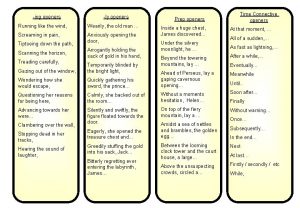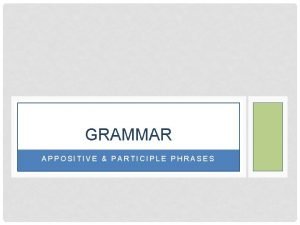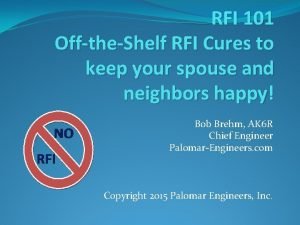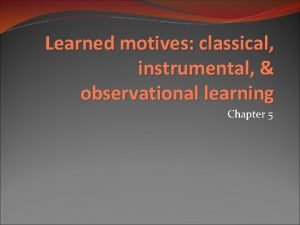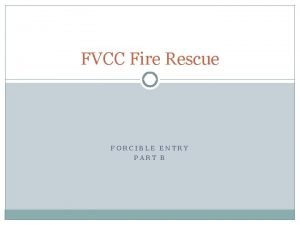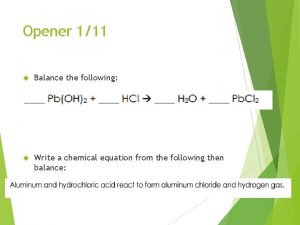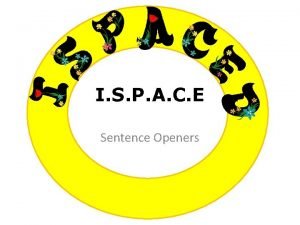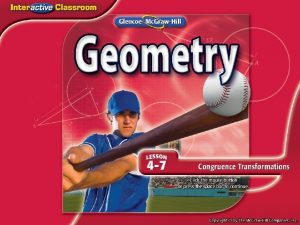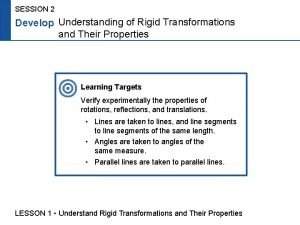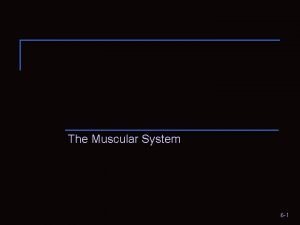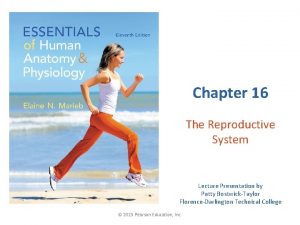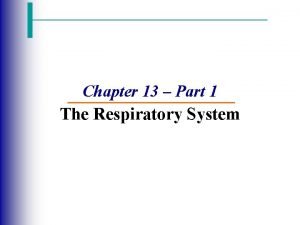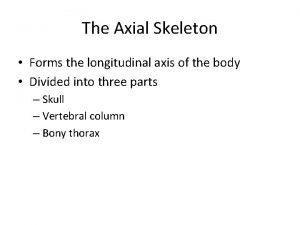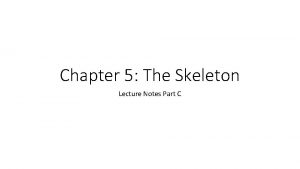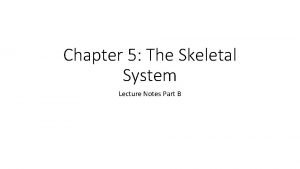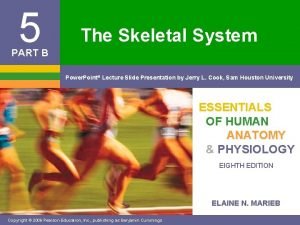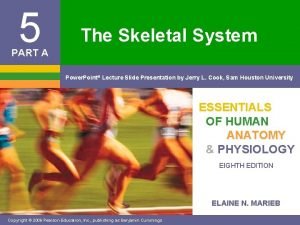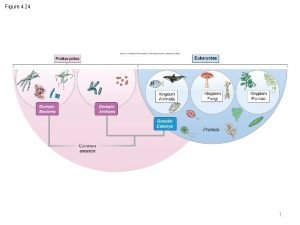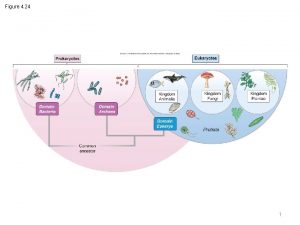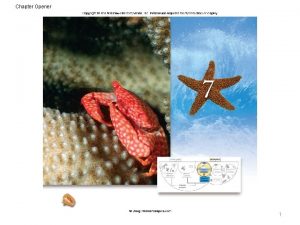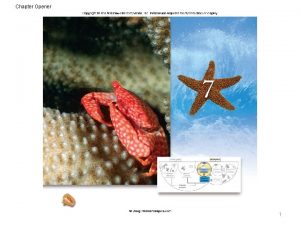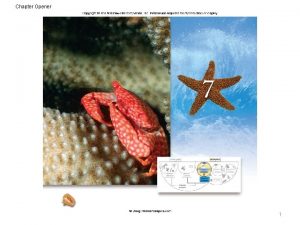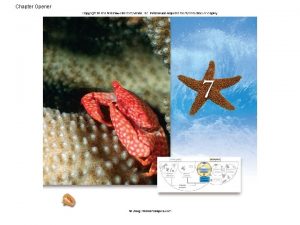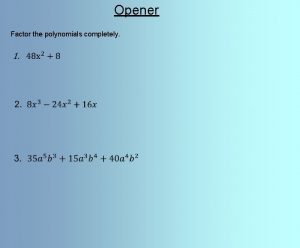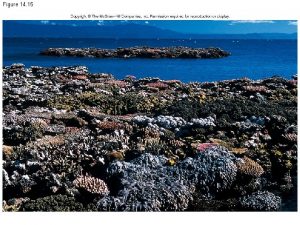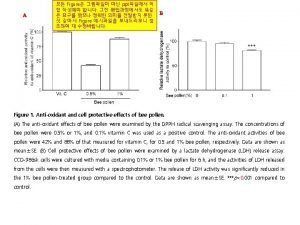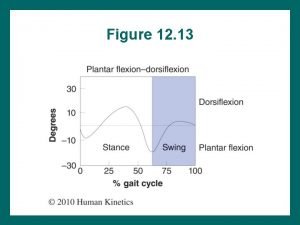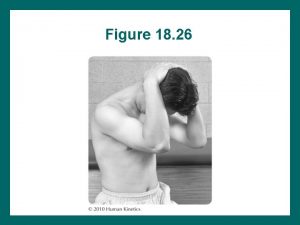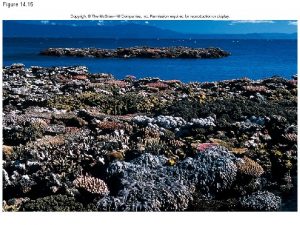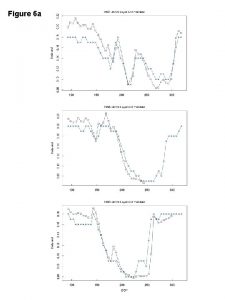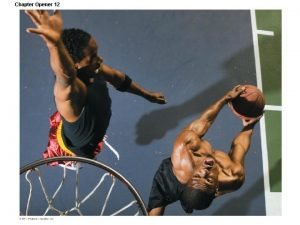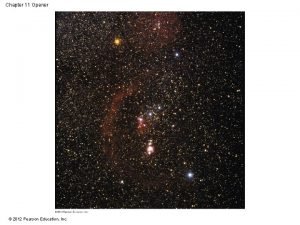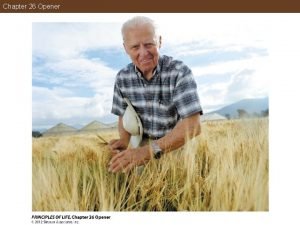Chapter Opener 1 Figure 7 54 2 Characteristics



































- Slides: 35

Chapter Opener 1

Figure 7. 54 2

Characteristics of Major Animal Phyla 3

Invertebrates - Echinoderms • Echinodermata 극피동물문 echinoderms • Characteristics of Phylum: – Name means "Spiny Skin" 가시를 가진 피부 – Endoskeleton 내골격 – Water vascular system with tube feet important in feeding and locomotion 수관계 관족 팽대부ampullae 천공판madreporite – Skin gills for respiration – Radial symmetry 방사대칭 in adults - larvae are bilaterally symmetrical 좌우대칭 유생 – Nervous system is decentralized - no brain - this allows any portion of the body to lead – Can regenerate lost body parts – All 7000 species exclusively marine 4

five classes of living echinoderms traditional taxonomy, five classes of living echinoderms: • Crinoidea (sea lilies) 바다나리류 • Asteroidea (starfish) 별불가사리류 sea star • Ophiuroidea (brittle stars or snake stars) 거미불가사리류 • Echinoidea (sea urchins and sand dollars) 성게류 • Holothuroidea (sea cucumbers) 해삼류 • An unusual echinoderm, Xyloplax , was found in 1986, on sunken wood in the deep sea. It may represent a sixth class, the Concentricycloidea (Baker et al. , 1986), but many zoologists now consider Xyloplax to be an aberrant asteroid. • http: //www. ucmp. berkeley. edu/echinodermata/echinosy. html five classes of living echinoderms 5

Echinoderms – 극피동물 계통분류 http: //www. ucmp. berkeley. edu/echinodermata/echinosy. html 6

Invertebrates – Echinoderms – 극피동물 계통 http: //tolweb. org/Echinodermata 7


Invertebrates - Echinoderms • Crinoidea 바다나리강 crinoids – Represented by feather stars 갯고사리류 and sea lilies 바다백합 – 600 species are typically found in deep water – Sea lilies live attached while feather stars are mobile – These organisms have 5 or more arms that branch out for suspension feeding – Some use a mucous net to aid in food capture – 관족 점액 분비, 섬모성 관족대, 현탁물 섭식 수 류 방향 9

Invertebrates - Echinoderms 10

Invertebrates - Echinoderms • Asteroidea 불가사리강 sea stars, starfish – Move with tube feet, ambulacral groove 보대구 – Have a central disc in center of body surrounded by five arms (or multiples of 5 arms – some species have 50 arms) – Internal organs extend through the entire body, including the arms – Calcium carbonate plates are loosely embedded in spiny skin making them slightly flexible – Carnivores that normally consume shellfish and coral – Pedicellaria 차극 11


Invertebrates - Echinoderms 13

Invertebrates - Echinoderms • Ophiuroidea 거미불가사리강 brittle stars – Like sea stars, they have a central disc surrounded by arms – Five arms seen in brittle stars are thin and covered in numerous spines – Internal organs are restricted to the central disc – The tube feet present in brittle stars are without suckers and used for feeding on detritus and small animals 14

Invertebrates - Echinoderms 15

Invertebrates - Echinoderms • Echinoidea 성게강 • sea urchins 성게, sea biscuits, sand dollars 연입성게류 – Elongated, movable spines much longer than those sea in other groups 가시와 차극 – Rigid plates are fused into a solid structure called a “test” 외각(껍데기) – Move with tube feet – Mouth on the bottom, anus on top of body – Biting mouth for grazing – aristotles lantern is the feeding structure of muscles and mouthpieces 아리스 토텔레스 등 – Feed on detritus, encrusting organisms, algae or anything else they can scrape off surfaces 16

Invertebrates - Echinoderms 17


Invertebrates - Echinoderms • Holothuroidea 해삼강 sea cucumbers – Five rows of two feet are restricted to one side, where the animal lies 5줄 관족 – The plates found in the sea cucumbers are loosely embedded in the thick skin 석회질 골편 – They are deposit feeders 퇴적물 섭식자 – Sea cucumbers have a interesting predator escape plan called evisceration 내장적출, where they expel the internal organs; it is assumed this allows escape for the sea cucumber. – Since all echinoderms have regenerative capabilities, these internal organs will grow back. 19

Invertebrates - Echinoderms 20

Invertebrates - Hemichordates • Hemichordata 반삭동물문 hemichordates • Characteristics of Phylum: – Although a rare group, these worms seem to span a gap between invertebrates and more advanced chordate animals “단절고리? ” – Acorn worms (장생동물류 별벌레아재비류 enteropneusts) share some features with chordates including pharnyngeal gill slits, nerve cord and a stomocord that is similar to the chordate notochord 비 어있는 배부 신경삭; 소화관의 앞부분에 새열공 존재 – Acorn worms are deposit or suspension feeders and use proboscis for feeding – Acorn worms have larvae that resemble those seen in echinoderms – 85 known species 21

(현재 존재하는 반삭동물문 장새강의 바 다 동물인 Harrimania planktophilus. 몸길이 32 mm 정도의 관처럼 생긴 벌레 인데 서구권에서는 스파게티 모양이라 고 보는 모양. 왼쪽에 있는 것이 입. Two individuals of Harrimania planktophilus, a modern enteropneust (harrimaniid) worm. Proboscis to the left. Total length of a relaxed and uncoiled animal is approximately 32 mm. (Credit: C. B. Cameron, Université de Montréal. ) Spartobranchus tenuis 의 복원도 Credit: C. B. Cameron, Université de Montréal. ) 22

Invertebrate Chordates • The Phylum Chordata 척삭동물문 is a phylum that contains two invertebrate groups, tunicates 피낭류 and lancelets 창고기류, as well as many other, more familiar animals such as fish, amphibians, reptiles, birds and mammals. • Chordates have several features that are seen at least during some portion of the life. • Lancelets are the only chordates that possess all the features as adults. 23

Invertebrate Chordates • Characteristics of Chordates: – Notochord - nerve cord support – Tubular nerve cord – Muscular pharynx – Gill slits – Post-Anal Tail – Ventral heart 24


http: //ko. wikipedia. org/wiki/%EC%B 2%99%EC%82%AD%EB%8 F%99%EB%AC%BC 26

Invertebrate Chordates • Urochordata 미삭동물아문 tunicates 피낭류 • Characteristics of (sub)Phylum: – Commonly called “sea squirts” 우렁쉥이 because they filter feed via an incurrent siphon 입수관 and “squirt” 바다물총 water out (excurrent siphon 출수관) a siphon after the water has been filtered – Larvae has chordate characteristics that are not seen in adultsonly pharynx remains 올챙이 유생 tadpole larva 새열, 배축 신경 삭, 척상과 항문후방꼬리, 눈 – Called tunicates because of thick outer covering called a tunic – Larvae are free swimming after fertilization occurs in open watermass reproduction – Adults normally live attached to boats, docks, reefs, or other hard substrate; All 3000 known species are marine 27

Figure 7. 51 a 28




Invertebrate Chordates • Cephalochordata 두삭동물아문 • Lancelets 창고기류 • Characteristics of (sub)Phylum: – 23 species – Very small, only up to 3 inches long – Live in shallow marine waters as filter feeders – Body shows segmented muscle tissue – Notochord attached to the muscles – Gills are used to filter food, not in respiration – Possess all chordate features as an adult 32


Figure 7. 54 34

Characteristics of Major Animal Phyla 35
 What are sentence openers
What are sentence openers Appositive sentence opener
Appositive sentence opener Ing openers list
Ing openers list Adverb openers
Adverb openers Participial and prepositional phrases
Participial and prepositional phrases Whats an appositive phrase
Whats an appositive phrase Rfi vs rfp
Rfi vs rfp Ing sentence starters
Ing sentence starters Wheel and axle
Wheel and axle Participle opener
Participle opener What is classical conditioning example
What is classical conditioning example Rescue forcible entry tools door opener
Rescue forcible entry tools door opener Balance opener
Balance opener Ispace sentence openers
Ispace sentence openers Garage door installation edmonton
Garage door installation edmonton A transformation is an operation that
A transformation is an operation that 8 figure grid reference example
8 figure grid reference example Rigid transformation review
Rigid transformation review Start area
Start area Chapter 6 the muscular system figure 6-9
Chapter 6 the muscular system figure 6-9 Chapter 16 the reproductive system figure 16-2
Chapter 16 the reproductive system figure 16-2 Kidney pyramid labeled
Kidney pyramid labeled Chapter 13 respiratory system figure 13-1
Chapter 13 respiratory system figure 13-1 Figure 11-7 veins labeled
Figure 11-7 veins labeled Figure 11-9 is a diagram of the hepatic portal circulation
Figure 11-9 is a diagram of the hepatic portal circulation Chapter 6 the muscular system figure 6-12
Chapter 6 the muscular system figure 6-12 Hollow portions of bones surrounding the nasal cavity
Hollow portions of bones surrounding the nasal cavity Microscopic anatomy of skeletal muscle figure 6-2
Microscopic anatomy of skeletal muscle figure 6-2 Figure 5-13 is a diagram of the articulated skeleton
Figure 5-13 is a diagram of the articulated skeleton Typical vertebra superior view
Typical vertebra superior view Chapter 5 the skeletal system figure 5-10
Chapter 5 the skeletal system figure 5-10 Chapter 3 cells and tissues figure 3-7
Chapter 3 cells and tissues figure 3-7 Cell membrane phospholipids
Cell membrane phospholipids Chapter 5 the skeletal system figure 5-10
Chapter 5 the skeletal system figure 5-10 Chapter 5 the skeletal system figure 5-10
Chapter 5 the skeletal system figure 5-10 What is the function of the golgi apparatus
What is the function of the golgi apparatus


